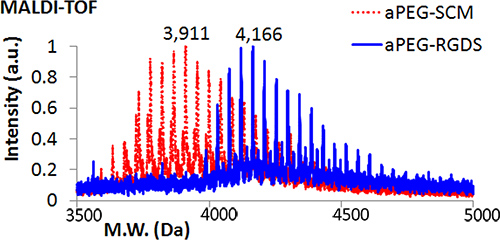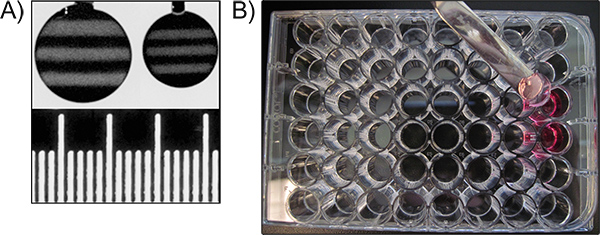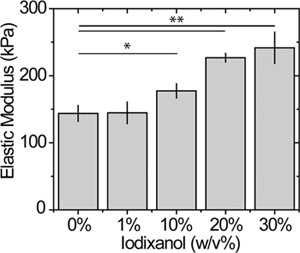Method Article
Density Gradient Multilayered Polymerization (DGMP): A Novel Technique for Creating Multi-compartment, Customizable Scaffolds for Tissue Engineering
In This Article
Summary
Here we describe a unique strategy for creating biocompatible, layered matrices with continuous interfaces between distinct layers for tissue engineering. Such a scaffold could provide an ideal customizable environment to modulate cell behavior by various biological, chemical or mechanical cues
Abstract
Complex tissue culture matrices, in which types and concentrations of biological stimuli (e.g. growth factors, inhibitors, or small molecules) or matrix structure (e.g. composition, concentration, or stiffness of the matrix) vary over space, would enable a wide range of investigations concerning how these variables affect cell differentiation, migration, and other phenomena. The major challenge in creating layered matrices is maintaining the structural integrity of layer interfaces without diffusion of individual components from each layer1. Current methodologies to achieve this include photopatterning2-3, lithography4, sequential functionalization5, freeze drying6, microfluidics7, or centrifugation8, many of which require sophisticated instrumentation and technical skills. Others rely on sequential attachment of individual layers, which may lead to delamination of layers9.
DGMP overcomes these issues by using an inert density modifier such as iodixanol to create layers of varying densities10. Since the density modifier can be mixed with any prepolymer or bioactive molecule, DGMP allows each scaffold layer to be customized. Simply varying the concentration of the density modifier prevents mixing of adjacent layers while they remain aqueous. Subsequent single step polymerization gives rise to a structurally continuous multilayered scaffold, in which each layer has distinct chemical and mechanical properties. The density modifier can be easily removed with sufficient rinsing without perturbation of the individual layers or their components. This technique is therefore well suited for creating hydrogels of various sizes, shapes, and materials.
A protocol for fabricating a 2D-polyethylene glycol (PEG) gel, in which alternating layers incorporate RGDS-350, is outlined below. We use PEG because it is biocompatible and inert. RGDS, a cell adhesion peptide11, is used to demonstrate spatial restriction of a biological cue, and the conjugation of a fluorophore (Alexa Fluor 350) enables us to visually distinguish various layers. This procedure can be adapted for other materials (e.g. collagen, hyaluronan, etc.) and can be extended to fabricate 3D gels with some modifications10.
Protocol
1. Synthesis of Fluorescently Labeled Acryloyl-PEG-RGDS
- React the RGDS peptide with acryloyl-PEG- succinimidyl carboxymethyl ester (aPEG-SCM, PEG MW: 3400 g/mol) and N-N diisopropylethylamine (DIPEA) at 1.2:1:2 molar ratios in dimethyl sulfoxide (DMSO) under argon at room temperature overnight.
- Confirm conjugation by matrix-assisted laser desorption/ionization time of flight (MALDI-TOF) mass spectrometry. Add 1 μl of aPEG-RGDS reaction solution to a sample spot on the MALDI target and dry. Prepare a saturated solution of Universal MALDI Matrix in tetrahydrofuran (THF) and vortex for 1 min. Add ~1 μl of this solution to the same sample spot. Repeat the procedure for aPEG-SCM for comparison. Load and analyze. The molecular weight of aPEG-RGDS should be greater than aPEG-SCM (Figure 2).
- To conjugate the fluorophore, add an equimolar amount of Alexa Fluor 350 carboxylic acid (succinimydyl ester), dissolved in a minimal volume of DMSO, to the aPEG-RGDS reaction solution from 1.1 and react under argon at room temperature overnight.
- Purify aPEG-RGDS-350 by dialyzing (MW 3500 Da) against DI-H2O at 4 °C for 48 hr at 1,000:1 volumetric ratio, exchanging dialysate at least twice per day.
- Freeze dry the purified aPEG-RGDS-350 in a Labconco Freezone Plus or equivalent freeze dry system and store at -20 °C.
2. Preparation of a 2D Mold and Fabrication of a 2D PEG Gel with Alternating RGDS-350 Layers
- Prepare hydrophobic glass slides. Place clean glass slides into a glass dish in a vacuum oven. Heat to 80 °C for 30 min to completely dry the surfaces. Place dish with slides in a fume hood and add 250 μl Sigmacote to each slide, gently rocking for 30 sec to coat entire surface. Thoroughly rinse the coated slides with 100% methanol, followed by washing in distilled water, soaking twice for 5 min in at least 10 ml.
- Cut silicone spacers (0.8 mm thick) with 10 mm biopsy punches.
- Autoclave the silicone spacers and Sigmacote-treated glass slides.
- Formulate solutions for each respective layer in individual microfuge tubes by mixing PEG diacrylate (PEGda) precursor (final concentration 15% w/v) with different amounts of iodixanol (60% stock solution in water) to yield varying final concentrations (e.g. 40%, 30%, 20% and 10%), supplementing the remaining volume with phosphate buffered saline (PBS) to obtain solutions of graded densities. In a similar manner, for alternating layers, mix aPEG-RGDS-350 (final concentration 8 mM) with iodixanol and PBS to yield various concentrations (e.g. 35%, 25%, and 15%).
- Add photoinitiator (2-Hydroxy-4'-(2-hydroxyethoxy)-2-methylpropiophenone, 333mg/ml stock in N-vinyl pyrrolidone) to each solution for various layers (10 μl of stock solution per ml of each layer solution). Photoinitiator is added last to prevent polymerization before layering of the gels in the mold, as it is sensitive to light.
- Subsequent steps of this protocol will be performed in a biosafety cabinet to ensure sterility.
- Filter-sterilize each solution using a sterile 1 ml syringe and 0.2 μm filter. Assemble the mold setup by sandwiching the spacer between two Sigmacore-treated glass slides and secure with clamps placing as depicted in Figure 1.
- Cast the layered gels by adding the most dense solution (e.g. PEGda with 40% iodixanol) first, followed by a less dense solution (e.g. aPEG-RGDS-350 with 35% iodixanol). Repeat the alternate layering to achieve several layers of desired composition and densities as shown in Figure 1.
- Irradiate the mold with 365 nm light for 3 min using a portable UVR-9000 lamp. Allow the polymerized gels to cure for 5 min. Remove the clamps, then gently lift the top glass slide and the mold; the stratified DGMP gels will remain on the slides. Using a sterile spatula, carefully place the gels in a 50 ml tube containing sterile PBS or culture medium for washing.
- Wash the polymerized gels in PBS at 1,000:1 volumetric ratio, exchanging buffer at least twice per day to remove the density modifier, photoinitiator, and unreacted polymer. Alternatively, PBS may be exchanged with cell growth medium. Store the DGMP gels in PBS or growth medium for the cell culture experiment outlined in Step 3.
- To visualize alternating layers, arrange DGMP gel (these gels will not be usable for cell culture) along a ruler on the sample tray of a VersaDoc gel documentation unit. Expose the gels in 350 nm; the exposure time will vary depending on the concentration of the fluorophore. Alternating dark and blue bands in the DGMP hydrogel demonstrate formation of discrete layers of distinct chemical composition (Figure 3).
3. 2D Cell Culture on DGMP Gels
- For gels incorporating RGDS peptide, use adhesion dependent cells, such as C2C12 myoblasts.
- Gently insert DGMP gels (stored in PBS) into the wells of 48-well cell culture plates using a sterile cell scraper in a biosafety cabinet.
- Pre-warm growth medium (Dulbecco's modified Eagle's medium or DMEM supplemented with 10% v/v fetal bovine serum and 1% v/v 100x penicillin-streptomycin solution) and PBS in a water bath set at 37 °C.
- Wash a 60% confluent plate (10 mm) of C2C12 cells three times with PBS. Aspirate off PBS and harvest cells by adding 1 ml of 0.25% Trypsin-EDTA and incubating at 37 °C for 2 min. Resuspend the cells in growth medium and count cells. Seed the DGMP gel-containing cell culture well with C2C12 myoblasts (20,000 cells/ cm2). Incubate the cells at 37 °C in 5%CO2/95% relative humidity. Gently exchange medium after 4 hr, careful not to remove lightly adhered cells.
- After 24 hr, the attachment of C2C12 myoblasts on the RGDS-containing layers of DGMP gels may be confirmed by epifluorescence and phase contrast microscopy (Zeiss Axiovert 200).
Results
MALDI-TOF analysis confirms the conjugation of RGDS peptide to acryloyl-PEG (Figure 2). Gel imaging reveals alternating RGDS- 350 (blue) layers after photopolymerization (Figure 3A). As shown in Figure 3A, 2D DGMP gel size can be varied based on the diameter of the silicone molds (10 mm, left ; 8 mm, right), and therefore are easily customizable for use in multiple assays – in this case to fit a 48 well cell culture plate (Figure 3B). Epifluorescence and phase contrast microscopy of C2C12 myoblasts cultured on a DGMP gel shows selective attachment on RGDS-350-containing PEG layers (Figure 4), demonstrating compartmentalization of the cell adhesion peptide (RGDS).

Figure 1. Molecular weight analysis by MALDI-TOF comparing aPEG-SCM to aPEG-RGDS obtained after conjugation of RGDS peptide.

Figure 2. Schematic representation of DGMP gel fabrication. After the gradients are layered, they can be allowed to settle for varying periods of time (ts) to create graduated interfaces, followed by photopolymerization. Stratified DGMP gels can be easily extracted from the mold for further use. Click here to view larger figure.

Figure 3. A) 2D multilayered gels obtained after photopolymerization imaged using 350 nm and white light channels of VersaDoc gel documentation unit. The grayscale image reveals alternating layers containing RGDS in white. B) Insertion of DGMP gel into 48-well cell culture dishes.

Figure 4. Merged phase contrast and epifluorescence image of C2C12 myoblasts grown on DGMP gels (scale bar 50 μm).

Figure 5. Effect of iodixanol on gel surface elasticity. Atomic force microscopy measurements of static samples of crosslinked PEG substrates using previously established methods with a 2 nN force trigger 12. *p< 0.05 and **p<0.01.
Discussion
DGMP is a simple strategy for preparing multilayered gels that does not rely on expensive instrumentation. This protocol can be adapted for creating scaffolds using other biocompatible materials, such as collagen and hyaluronic acid. Bioactive small molecules, for example cell adhesion-promoting RGDS peptide, can be tethered to the polymer matrix to prevent mixing of cues between layers. Proteins can be encapsulated in distinct layers without the need for chemical conjugation as they, depending on the matrix mesh size, are less prone to diffuse through hydrogels10. Here we used iodixanol (Nycoprep), an inert density modifier, which has previously been used for viable cell applications. Other density modifiers such as sucrose and dextrose can also be used. By varying the settling time (ts), one can fine-tune the interfaces between two layers to produce smooth or sharp transitions as needed (longer settling time gives smoother transitions)10. For example, smoother transitions between DGMP gel layers could be used to generate a continuous gradient of a biological cue to study cell processes such as chemotaxis.
The effect of density modifier on gel stiffness is shown in Figure 5 for a 15% aPEGda gel; a more complete characterization of stiffness and porosity as a function of PEGda and iodixanol concentrations is currently being evaluated. While the PEGda concentration in this example is relatively high, we observed a 60% greater elastic modulus in gels with 30% iodixanol compared to gels without. The change in gel stiffness can be adjusted for by modulating the macromer concentration or crosslinking density.
We have also applied the DGMP technique to create 3D multilayered gels using polyacrylamide and PEG precursors10. Varying the concentration or the degree of crosslinking of the prepolymer allows structural variation in the scaffolds, which can be used to explore cell behavior such as polarized growth and migration in 3D.
In summary, DGMP is an adaptable technique that can be applied to fabricate 2D and 3D scaffolds from a variety of biocompatible materials for a broad range of biomedical and basic research applications.
Disclosures
The authors have no conflicting interests to disclose.
Acknowledgements
The authors are grateful for support from NIH Director's New Innovator Awards (1DP2 OD006499-01 to A.A. and 1DP2 OD006460-01 to A.J.E.), and King Abdulaziz City for Science and Technology (UC San Diego Center of Excellence in Nanomedicine). We would like to thank Ms. Jessica Moore for her critical comments on the manuscript.
Materials
| Name | Company | Catalog Number | Comments |
| Polyethylene glycol succinimydyl carboxymethyl (a-PEG-SCM) | Laysan | 120-64 | |
| Polyethelyene glycol diacrylate (PEGda) | Dajac Labs | 9359 | |
| Arginine-Glycine-Aspartic acid-Serine (RGDS) | American Peptide | 49-01-4 | |
| N,N- Diisopropylethylamine (DIPEA) | Sigma | D125806 | |
| Dimethyl sulfoxide (DMSO) | Sigma | D2438 | |
| N,N- dimethylformamide (DMF) | Fisher | D119-4 | |
| Tetrahydrofuran (THF) | Fisher | T397 | |
| Dialysis cassette (3500 Da) | Thermo Scientific | 66330 | |
| Alexa Fluor 350 carboxylic acid succinimydyl ester | Life Technologies | A-10168 | |
| Sigmacote | Sigma | SL2 | |
| Silicone spacers | Grainger | 1MWA4 | |
| Biopsy punches | Acuderm | P1025 (10 mm) P850 (8 mm) | |
| Dulbecco's phosphate buffered saline (DPBS) | Hyclone | SH30028 | |
| Iodixanol (NycoPrep) | Fisher | NC9388846 | |
| 2-Hydroxy-4'-(2-hydroxyethoxy)-2-methylpropiophenone | Sigma | 410896 | |
| Dulbecco's modified Eagle's medium (DMEM) | Life Technologies | 11054 | |
| Fetal bovine serum | Life Technologies | 10082 | |
| Penicillin-streptomycin | Life Technologies | 15140 | |
| C2C12 myoblasts | ATCC | CRL-1772 | |
| MALDI | Bruker | N/A | |
| UVR-9000 | Bayco | UVR-9000 | |
| VersaDoc | Bio-Rad | N/A |
References
- Place, E. S., Evans, N. D., Stevens, M. M. Complexity in biomaterials for tissue engineering. Nat. Mater. 8, 457-470 (2009).
- Liu, V. A., Jastromb, W. E., Bhatia, S. N. Engineering protein and cell adhesivity using PEO-terminated triblock polymers. J. Biomed. Mater. Res. 60, 126-134 (2002).
- Sharma, B., et al. Designing zonal organization into tissue-engineered cartilage. Tissue Eng. 13, 405-414 (2007).
- Hahn, M. S., et al. Photolithographic patterning of polyethylene glycol hydrogels. Biomaterials. 27, 2519-2524 (2006).
- Kizilel, S., Sawardecker, E., Teymour, F., Perez-Luna, V. H. Sequential formation of covalently bonded hydrogel multilayers through surface initiated photopolymerization. Biomaterials. 27, 1209-1215 (2006).
- Harley, B. A., et al. Design of a multiphase osteochondral scaffold. II. Fabrication of a mineralized collagen-glycosaminoglycan scaffold. J. Biomed. Mater. Res. A. 92, 1066-1077 (2010).
- Cuchiara, M. P., Allen, A. C., Chen, T. M., Miller, J. S., West, J. L. Multilayer microfluidic PEGDA hydrogels. Biomaterials. 31, 5491-5497 (2010).
- Roam, J. L., Xu, H., Nguyen, P. K., Elbert, D. L. The formation of protein concentration gradients mediated by density differences of poly(ethylene glycol) microspheres. Biomaterials. 31, 8642-8650 (2010).
- Gleghorn, J. P., Lee, C. S., Cabodi, M., Stroock, A. D., Bonassar, L. J. Adhesive properties of laminated alginate gels for tissue engineering of layered structures. J. Biomed. Mater. Res. A. 85, 611-618 (2008).
- Karpiak, J. V., Ner, Y., Almutairi, A. Density gradient multilayer polymerization for creating complex tissue. Adv. Mater. 24, 1466-1470 (2012).
- Pierschbacher, M. D., Ruoslahti, E. Cell attachment activity of fibronectin can be duplicated by small synthetic fragments of the molecule. Nature. 309, 30-33 (1984).
- Kaushik, G., Fuhrmann, A., Cammarato, A., Engler, A. J. In Situ Mechanical Analysis of Myofibrillar Perturbation and Aging on Soft, Bilayered Drosophila Myocardium. Biophysical Journal. 101, 2629-2637 (2011).
Reprints and Permissions
Request permission to reuse the text or figures of this JoVE article
Request PermissionThis article has been published
Video Coming Soon
Copyright © 2025 MyJoVE Corporation. All rights reserved